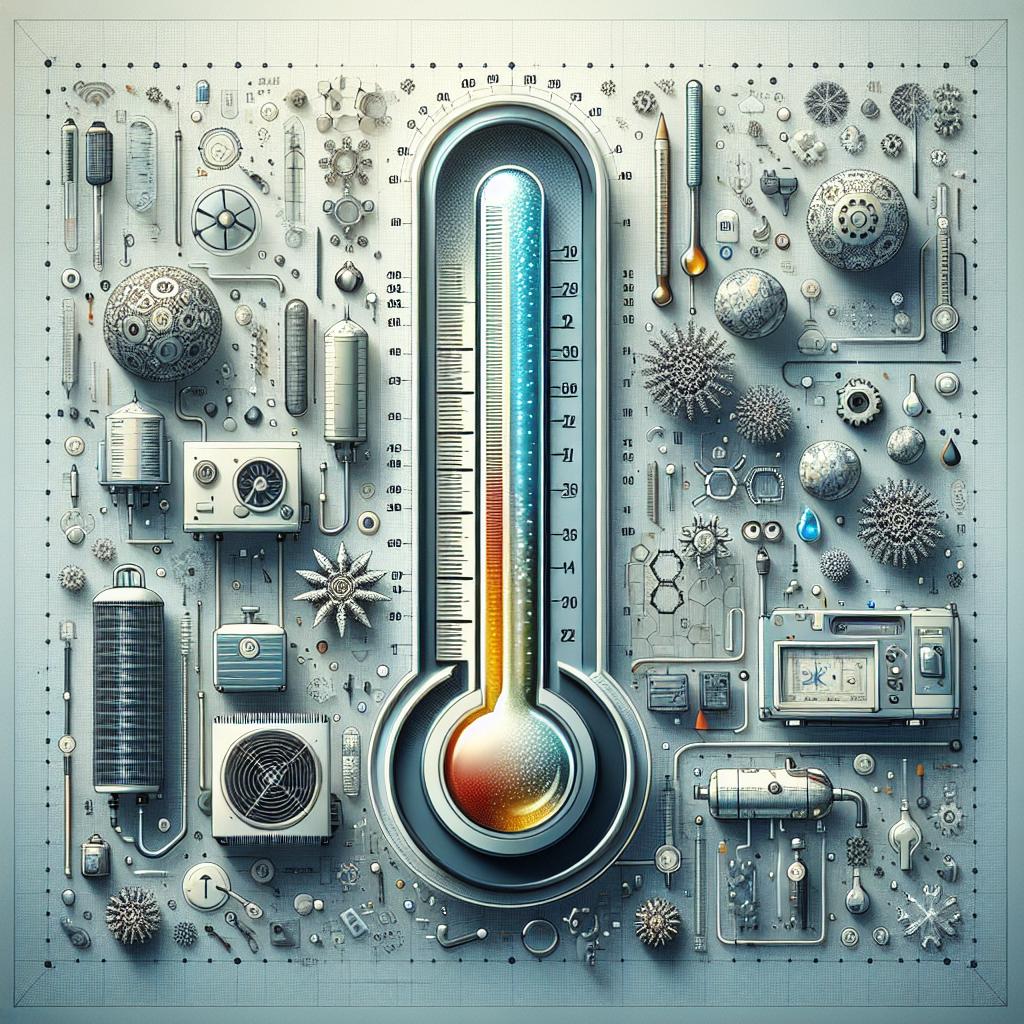Unlocking the Secrets of HVAC Subcooling: A Comprehensive Guide to Charging Systems
In the intricate world of HVAC systems, where comfort meets engineering, understanding the nuances of subcooling is essential for technicians and enthusiasts alike. Subcooling—often seen as a mere technical term—plays a pivotal role in optimizing the efficiency and performance of cooling systems, ensuring that every drop of refrigerant is utilized effectively. Whether you’re a seasoned professional looking to refine your skills or a newcomer eager to navigate the complexities of air conditioning systems, grasping the art of charging for subcooling is fundamental. In this article, we will demystify the process of charging HVAC systems under subcooled conditions, offering step-by-step guidance, practical tips, and expert insights to empower you to tackle this vital component of HVAC maintenance with confidence. Join us on this journey as we explore the essential principles, tools, and techniques that will enhance your understanding and command over HVAC subcooling.
Understanding Subcooling in HVAC Systems
Subcooling plays a critical role in optimizing the efficiency and performance of HVAC systems. It refers to the process of lowering the refrigerant’s temperature below its saturation point after it has condensed into a liquid. Understanding the nuances of subcooling helps technicians ensure that the system operates at peak efficiency, reducing energy consumption and enhancing overall comfort. Key benefits of proper subcooling include:
- Increased efficiency: By ensuring the refrigerant is fully condensed, systems use less electricity.
- Enhanced capacity: Adequate subcooling allows the system to deliver more consistent cooling without overheating.
- Reduced compressor wear: Keeping the compressor at optimal operating conditions prolongs its lifespan.
To measure and charge subcooling effectively, technicians can utilize a combination of thermometer readings and pressure measurements. It’s essential to calculate the subcooling level by comparing the actual liquid line temperature with the saturation temperature at the liquid line pressure. This comparison enables the technician to determine the necessary adjustments. A helpful guideline could be presented in a simple table:
| Refrigerant Type | Saturation Temp (°F) | Optimal Subcooling (°F) |
|---|---|---|
| R-410A | 120 | 5-15 |
| R-22 | 90 | 10-20 |
| R-134A | 70 | 5-15 |
By following these processes and maintaining the appropriate subcooling levels, HVAC professionals can not only achieve better performance but also ensure the longevity and reliability of the systems they service.

The Importance of Accurate Refrigerant Levels
Maintaining precise refrigerant levels in your HVAC system is crucial for optimal performance and efficiency. Inadequate refrigerant can lead to various issues, including decreased cooling capacity and increased energy consumption, while excessive refrigerant can cause compressor damage and other mechanical failures. Understanding the significance of correct refrigerant levels ensures not just a comfortable indoor environment, but also prolongs the lifespan of your equipment. Here are some key reasons why accurate refrigerant levels matter:
- Enhanced System Efficiency: Proper refrigerant levels help your HVAC system operate efficiently, reducing energy costs.
- Improved Comfort: Maintaining the right refrigerant balance ensures consistent temperature control, keeping indoor spaces comfortable.
- Reduced Repair Costs: Timely detection and correction of refrigerant levels prevent costly repairs or replacements down the line.
Moreover, regular monitoring and charging of refrigerant during maintenance can prevent potential issues and enhance system reliability. It’s wise to keep an eye on the system’s pressures and temperatures, making adjustments as needed to optimize performance. Using a table to summarize acceptable refrigerant levels based on common HVAC types can also serve as a critical reference during maintenance checks:
| HVAC Type | Recommended Refrigerant Level (psi) |
|---|---|
| Residential Split System | 60-70 psi |
| Commercial Rooftop Unit | 40-50 psi |
| Heat Pump Systems | 50-60 psi |

Step-by-Step Guide to Charging Subcooling Effectively
To charge your HVAC system for optimal subcooling, begin by ensuring that your system is set up properly and all components are functioning. Start by checking the manufacturer’s specifications for the appropriate refrigerant and the recommended subcooling range. Next, gather your required tools, which typically include:
- Pressure gauges for monitoring refrigerant pressure
- Thermometers to measure the temperature difference
- Vacuum pump to evacuate the system if necessary
- Refrigerant cylinder for charging
With your tools ready, follow these essential steps to achieve the desired level of subcooling:
- Start by measuring the liquid line temperature and pressure.
- Calculate the current subcooling by comparing temperature and pressure readings with the manufacturer’s chart.
- Add refrigerant carefully while monitoring both pressure and temperature to achieve the proper subcooling level.
- Once you have reached the desired subcooling, verify the system’s performance under various operating conditions.
Using a proper charging chart can simplify the process. Here’s a brief overview:
| Refrigerant Type | Subcooling (°F) |
|---|---|
| R-410A | 10-15 |
| R-22 | 8-12 |
| R-32 | 8-12 |
By mastering these steps and keeping an eye on your pressure and temperature readings, you can effectively charge your HVAC system for optimal performance and efficiency.

Common Challenges and Solutions When Charging Subcooling
Charging subcooling can often present several challenges for HVAC technicians, particularly when it comes to achieving the optimal balance of refrigerant. One common issue is overcharging, which can lead to inefficiencies and compressor damage. To counter this, it is essential to regularly monitor the refrigerant levels during the charging process and utilize accurate measurement tools. Additionally, fluctuations in ambient temperature can affect the performance of the system, making it vital to account for environmental conditions when determining the appropriate charge. In such cases, consider using a structured approach to monitoring system performance under various conditions.
Another frequent challenge is the inability to achieve the desired subcooling setpoint. This could stem from a range of problems, including inadequate airflow or a malfunctioning expansion valve. To remedy this, first ensure that the air filter is clean and the coils are free from debris for optimal airflow. Additionally, testing and possibly adjusting the expansion valve settings may help achieve a proper refrigerant flow. When troubleshooting, keep in mind that the indoor and outdoor temperatures can also have a substantial impact, so maintaining clear records of these conditions can help streamline the charging process. Below is a simple reference table for troubleshooting subcooling issues:
| Issue | Potential Cause | Solution |
|---|---|---|
| Overcharging | Poor measurement accuracy | Use calibrated gauges |
| Low subcooling | Improper airflow | Check and clean filters |
| High discharge pressure | Expansion valve malfunction | Inspect and adjust valve |
Q&A
Q&A: How to Charge HVAC Subcooling
Q1: What is subcooling in HVAC systems, and why is it important?
A1: Subcooling is the process of cooling refrigerant below its condensing temperature after it has turned into a liquid. It plays a critical role in maximizing the efficiency of an HVAC system by ensuring that the refrigerant is fully condensed before entering the expansion valve. This helps improve the system’s capacity, efficiency, and overall performance, ultimately leading to better comfort levels and reduced energy costs.
Q2: How do I know if my HVAC system needs subcooling?
A2: If your system is experiencing inconsistent temperatures, inadequate cooling, or increased energy bills, it might be time to check the subcooling levels. Additionally, low refrigerant levels, high suction pressures, or visible frost on the evaporator can indicate subcooling issues. Conducting regular system checks can help identify potential problems before they escalate.
Q3: What tools do I need to charge HVAC subcooling effectively?
A3: To charge subcooling properly, you’ll need a few essential tools: a digital or analog manifold gauge set, a refrigerant scale, a temperature probe, and safety equipment such as gloves and goggles. These tools will help you monitor pressures, measure subcooling, and safely handle refrigerants.
Q4: Can you walk me through the steps of charging the subcooling in an HVAC system?
A4: Absolutely! Here’s a simplified step-by-step guide:
- Establish Ambient Conditions: Ensure the system is running and the ambient temperature is stable.
- Connect Gauges: Attach the manifold gauge set to the high and low-pressure service ports.
- Calculate Subcooling: Use a temperature probe to measure the liquid line temperature near the condenser and subtract this from the saturation temperature (obtained from the high-pressure gauge).
- Add Refrigerant: If the subcooling is too low (typically should be between 8-12°F), carefully add refrigerant through the high-side port while monitoring the gauges and your calculations.
- Monitor and Adjust: Continuously check your readings and make gradual adjustments until the desired subcooling level is achieved.
- Seal and Test: Once the subcooling is at the right level, disconnect the gauges and check for leaks.
Q5: Are there any safety precautions I should take while charging subcooling?
A5: Safety is paramount when handling refrigerants. Always wear appropriate safety gear, including gloves and goggles. Work in a well-ventilated area, and ensure all connections are secure to prevent leaks. Be aware of the specific refrigerant you’re working with, as different types can have varying safety concerns. Consulting the refrigerant’s safety data sheet (SDS) before beginning the work is always a smart idea.
Q6: Is it advisable to charge subcooling myself, or should I call a professional?
A6: While DIY enthusiasts can charge subcooling with the right knowledge and tools, improper handling can lead to system damage or safety risks. If you’re unsure about any part of the process or if your system requires a diagnostic assessment, it’s best to consult a qualified HVAC technician. They can ensure that everything is done correctly and efficiently.
Q7: What are the potential consequences of improper subcooling adjustments?
A7: Incorrect subcooling levels can lead to several issues, including reduced efficiency, overcharging or undercharging of refrigerant, increased wear and tear on the system, and higher energy costs. In severe cases, it can result in compressor failure. Striking the right balance with subcooling is essential for maintaining your HVAC system’s health.
Q8: Where can I find more information or resources about HVAC subcooling?
A8: Numerous resources are available online, including instructional videos, HVAC forums, and detailed guides from HVAC manufacturers. Your local library or community college may also offer classes or workshops on HVAC maintenance. Always seek reputable sources to ensure you’re getting accurate information.
With this comprehensive Q&A, we hope to provide clear insights into the process of charging HVAC subcooling and promote safe, effective maintenance of heating and cooling systems.
To Conclude
As we conclude our exploration of HVAC subcooling and the nuances of charging these systems, it’s clear that mastering this skill can significantly enhance the efficiency and longevity of your equipment. Just like a finely-tuned instrument, your HVAC system requires careful attention and proper techniques to perform at its best. By understanding the principles of subcooling and incorporating them into your maintenance routine, you’re not just improving comfort; you’re also contributing to energy savings and environmental sustainability.
Remember, the journey to proficiency in HVAC systems is an ongoing one. Each system presents its own challenges and learning opportunities. We encourage you to stay curious and keep refining your techniques. Armed with knowledge and practice, you’ll be well on your way to becoming an HVAC charging pro. Thank you for joining us on this journey, and may your systems run cool and efficiently, ensuring a comfortable atmosphere year-round.

